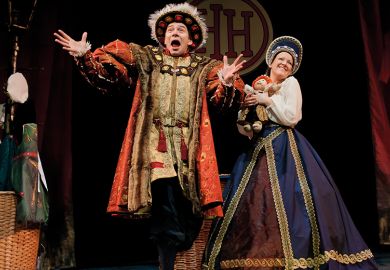Ten years ago James Shapiro published 1599: A Year in the Life of William Shakespeare, which shone a spotlight on Shakespeare’s life and plays at the turn of the 16th century. Now he has done the same to 1606. In some ways, 1599 was an obvious choice of year because it saw the opening of the Globe and heralded a turn in Shakespeare’s career away from comedy and history and towards tragedy. 1606 is a less obvious selection: why not 1603, the year that Elizabeth I died and James I succeeded her, or why not take 1601 and call it the year of Hamlet? That would be true to pretty much the same degree as calling 1606 “the year of Lear”, given that King Lear is, as Shapiro demonstrates, deeply rooted in a response to the events of late 1605, and that 1606 is also the year of Macbeth and of Antony and Cleopatra. So can 1606 really emulate the success of 1599?
It can very nearly. Shapiro shows that 1606 was indeed a pivotal year since it saw the execution of the Gunpowder plotters, the visit of Christian IV of Denmark and the reburial of Elizabeth, plague, continued discussion of union between England and Scotland, the launch of the Jamestown colony, a false rumour of King James’ death that caused panic in London, the passing of the Act to Restrain Abuses of Players, and the introduction of the Oath of Allegiance. Like its predecessor, too, this book is immensely readable and full of aperçus: that Shakespeare’s increasing propensity to co-authorship was probably related to the fact that he was no longer acting so much; that when he reused earlier work he almost always changed the starting point; that seeing Hymenaei might well have been the trigger for the inclusion of a triumph in Antony and Cleopatra.
Shapiro is less revelatory, however, on the way that King Lear speaks to issues of Britishness and union, on its echoes of the politically tinged exorcisms that had taken place in Denham in Buckinghamshire some years earlier, and on the influence of equivocation on Macbeth, because these are all topics that have already been extensively explored. He freely acknowledges his debts to previous scholars, and these sections are still elegant and entertaining and with much to offer to the general reader, but for Shakespeareans there will be few if any surprises. For a book called 1606 we also spend quite a lot of time in 1605, and although there are very few slips, it is irritating to find the surname of the Gunpowder conspirators Thomas and Robert Wintour given as Winter, since the fact that Thomas Wintour’s alleged confession was signed “Winter” was specifically adduced as evidence that it was a forgery. I also struggle to believe that Anne of Denmark can really be imagined as “caught between husband and brother” as Octavia was, and in general the chapter on Antony and Cleopatra is less persuasive than the other two.
Nevertheless, Shapiro’s new book is a pleasure to read, and it tells a happy story. It opens with Shakespeare at a low creative ebb, not doing as well under James as he had under Elizabeth, seemingly struggling for inspiration, and with less of his work in print. It goes on to trace how he recovered from this to produce three of his greatest plays, and our interest never flags along the way.
Lisa Hopkins is professor of English, Sheffield Hallam University.
1606: William Shakespeare and the Year of Lear
By James Shapiro
Faber & Faber, 448pp, £20.00
ISBN 9780571235780
Published 1 October 2015
Register to continue
Why register?
- Registration is free and only takes a moment
- Once registered, you can read 3 articles a month
- Sign up for our newsletter
Subscribe
Or subscribe for unlimited access to:
- Unlimited access to news, views, insights & reviews
- Digital editions
- Digital access to THE’s university and college rankings analysis
Already registered or a current subscriber? Login




